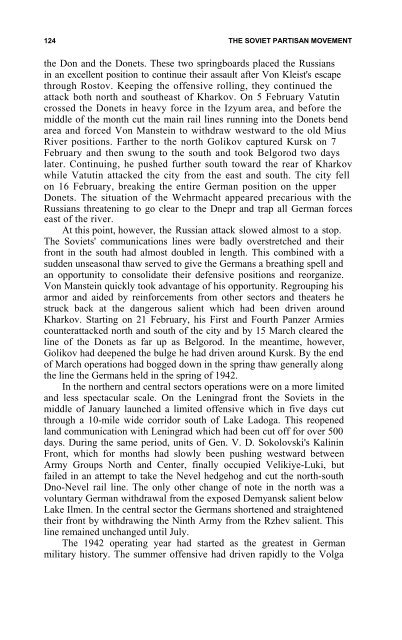the soviet partisan movement 1941-1944 by edgar m. howell
the soviet partisan movement 1941-1944 by edgar m. howell
the soviet partisan movement 1941-1944 by edgar m. howell
You also want an ePaper? Increase the reach of your titles
YUMPU automatically turns print PDFs into web optimized ePapers that Google loves.
124 THE SOVIET PARTISAN MOVEMENT<br />
<strong>the</strong> Don and <strong>the</strong> Donets. These two springboards placed <strong>the</strong> Russians<br />
in an excellent position to continue <strong>the</strong>ir assault after Von Kleist's escape<br />
through Rostov. Keeping <strong>the</strong> offensive rolling, <strong>the</strong>y continued <strong>the</strong><br />
attack both north and sou<strong>the</strong>ast of Kharkov. On 5 February Vatutin<br />
crossed <strong>the</strong> Donets in heavy force in <strong>the</strong> Izyum area, and before <strong>the</strong><br />
middle of <strong>the</strong> month cut <strong>the</strong> main rail lines running into <strong>the</strong> Donets bend<br />
area and forced Von Manstein to withdraw westward to <strong>the</strong> old Mius<br />
River positions. Far<strong>the</strong>r to <strong>the</strong> north Golikov captured Kursk on 7<br />
February and <strong>the</strong>n swung to <strong>the</strong> south and took Belgorod two days<br />
later. Continuing, he pushed fur<strong>the</strong>r south toward <strong>the</strong> rear of Kharkov<br />
while Vatutin attacked <strong>the</strong> city from <strong>the</strong> east and south. The city fell<br />
on 16 February, breaking <strong>the</strong> entire German position on <strong>the</strong> upper<br />
Donets. The situation of <strong>the</strong> Wehrmacht appeared precarious with <strong>the</strong><br />
Russians threatening to go clear to <strong>the</strong> Dnepr and trap all German forces<br />
east of <strong>the</strong> river.<br />
At this point, however, <strong>the</strong> Russian attack slowed almost to a stop.<br />
The Soviets' communications lines were badly overstretched and <strong>the</strong>ir<br />
front in <strong>the</strong> south had almost doubled in length. This combined with a<br />
sudden unseasonal thaw served to give <strong>the</strong> Germans a breathing spell and<br />
an opportunity to consolidate <strong>the</strong>ir defensive positions and reorganize.<br />
Von Manstein quickly took advantage of his opportunity. Regrouping his<br />
armor and aided <strong>by</strong> reinforcements from o<strong>the</strong>r sectors and <strong>the</strong>aters he<br />
struck back at <strong>the</strong> dangerous salient which had been driven around<br />
Kharkov. Starting on 21 February, his First and Fourth Panzer Armies<br />
counterattacked north and south of <strong>the</strong> city and <strong>by</strong> 15 March cleared <strong>the</strong><br />
line of <strong>the</strong> Donets as far up as Belgorod. In <strong>the</strong> meantime, however,<br />
Golikov had deepened <strong>the</strong> bulge he had driven around Kursk. By <strong>the</strong> end<br />
of March operations had bogged down in <strong>the</strong> spring thaw generally along<br />
<strong>the</strong> line <strong>the</strong> Germans held in <strong>the</strong> spring of 1942.<br />
In <strong>the</strong> nor<strong>the</strong>rn and central sectors operations were on a more limited<br />
and less spectacular scale. On <strong>the</strong> Leningrad front <strong>the</strong> Soviets in <strong>the</strong><br />
middle of January launched a limited offensive which in five days cut<br />
through a 10-mile wide corridor south of Lake Ladoga. This reopened<br />
land communication with Leningrad which had been cut off for over 500<br />
days. During <strong>the</strong> same period, units of Gen. V. D. Sokolovski's Kalinin<br />
Front, which for months had slowly been pushing westward between<br />
Army Groups North and Center, finally occupied Velikiye-Luki, but<br />
failed in an attempt to take <strong>the</strong> Nevel hedgehog and cut <strong>the</strong> north-south<br />
Dno-Nevel rail line. The only o<strong>the</strong>r change of note in <strong>the</strong> north was a<br />
voluntary German withdrawal from <strong>the</strong> exposed Demyansk salient below<br />
Lake Ilmen. In <strong>the</strong> central sector <strong>the</strong> Germans shortened and straightened<br />
<strong>the</strong>ir front <strong>by</strong> withdrawing <strong>the</strong> Ninth Army from <strong>the</strong> Rzhev salient. This<br />
line remained unchanged until July.<br />
The 1942 operating year had started as <strong>the</strong> greatest in German<br />
military history. The summer offensive had driven rapidly to <strong>the</strong> Volga
















